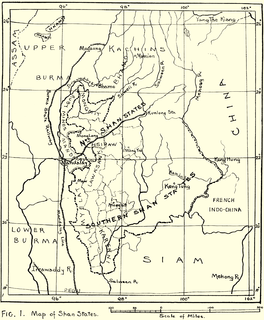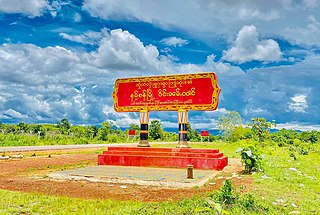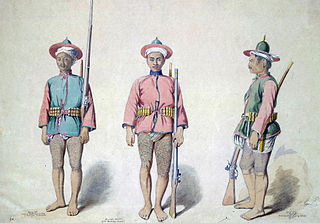Related Research Articles

The Shan people, also known as the Tai Long, or Tai Yai are a Tai ethnic group of Southeast Asia. The Shan are the biggest minority of Burma (Myanmar) and primarily live in the Shan State of this country, but also inhabit parts of Mandalay Region, Kachin State, and Kayin State, and in adjacent regions of China, Laos, Assam and Thailand. Though no reliable census has been taken in Burma since 1935, the Shan are estimated to number 4–6 million, with CIA Factbook giving an estimate of five million spread throughout Myanmar which is about 10% of the overall Burmese population.

Shan State also known by the endonyms Shanland, Muang Tai, and Tailong, is a state of Myanmar. Shan State borders China (Yunnan) to the north, Laos to the east, and Thailand to the south, and five administrative divisions of Burma (Myanmar) in the west. The largest of the 14 administrative divisions by land area, Shan State covers 155,800 km2, almost a quarter of the total area of Myanmar. The state gets its name from Burmese name for the Tai peoples: "Shan people". The Tai (Shan) constitute the majority among several ethnic groups that inhabit the area. Shanland is largely rural, with only three cities of significant size: Lashio, Kengtung, and the capital, Taunggyi. Taunggyi is 150.7 km northeast of the nation's capital Naypyitaw.

Khun Sa was an ethnic Chinese drug lord and warlord. He was born in Hpa Hpeung village, in the Loi Maw ward of Mongyai, Northern Shan State, Burma. Before he assumed the Shan name "Khun Sa" in 1976, he was known primarily by his Chinese name, Zhang Qifu (張奇夫).

Chao-Pha was a royal title used by the hereditary rulers of the Tai peoples of Mong Dun, Mong Shan, Mong Mao, kingdoms of Thai and Tai-Khamti people. According to local chronicles, some fiefdoms of Chao-Pha date from as early as the 2nd century BCE; however, the earlier sections of these chronicles are generally agreed to be legendary.

The Shan States (1885–1948) were a collection of minor Shan kingdoms called muang whose rulers bore the title saopha in British Burma. They were analogous to the princely states of British India.
Mong Ton also known historically as Möngtung and Maington, is a town and seat of Mong Tong Township in Mong Hsat District, Shan State in eastern Myanmar near the border with Thailand. Mong is equivalent to [Township or land]."Ton"is equivalent to [Royal City]. It is located in the Daen Lao Range, in the eastern part of the Shan State, east of the Salween River. Mong Ton lies on the National Highway 45 and connected to Nar Kaung Mu and Pone Par Kyin, is also connected to Mong Hsat by National Highway 49 which begins to the north-east of the town.
Mong Hsat is a town in the Shan State of Myanmar, the capital of Mong Hsat Township. It is served by Monghsat Airport.

Muang Mao, also spelled MöngMao or the Mao Kingdom was an ethnic Tai state that controlled several smaller Tai states or chieftainships along the frontier of what is now Myanmar, China, the states of Northeast India of Assam, and Arunachal Pradesh, principally set in the Dehong region of Yunnan with a capital near the modern-day border town of Ruili/Meng Mao. The name of the main river in this region is the Nam Mao, also known as the Shweli River.

The Shan State Army – South, also known simply as the Shan State Army, is the armed wing of the Restoration Council of Shan State (RCSS) and one of the largest insurgent groups in Myanmar (Burma). The SSA-S was led by Lieutenant General Yawd Serk until his resignation on 3 February 2014. Yawd Serk was reelected chairman of the RCSS shortly after his resignation and has remained chairman since.

Nansang is a town in Namsang District of Shan State in eastern Burma. It is the seat of Nansang Township. It is the biggest city of the eastern central of the Shan State in Myanmar. It is 72 miles away from Taunggyi. A pagoda lies in the southern part of the town. It is also known as Taung Paw Pagoda.

Mong Ton Township or Mong Tong Township is a township of Mongsat District in the Eastern Shan State of Myanmar. The capital town is Mong Ton. It borders Mong Pying Township to the north, Mong Hsat Township to the east, Mong Nai Township and Mong Pan Township to the west and Thailand to the south. Loi Hkilek mountain is located in the area. It has two townships. They are Pone Par Khem, and Mong Hta. At Mong Ton township, live in Shan, Lahu, Lisu, Wa, Burma, and Chinese.

The Mong Tai Army, was an insurgent group consisting of soldiers from the Shan minority in Myanmar, founded in 1985 by Khun Sa. It had up to 20,000 armed troops at its peak, and was one of the largest forces opposing the government of Myanmar at its time. It was also involved in drug trafficking in Southeast Asia.

The Burmese–Siamese War of 1849–1855 or Siamese Invasions of Kengtung or Kengtung Wars were military expeditions of the Siamese Rattanakosin Kingdom against the Tai Khün State of Kengtung, which had been under Burmese suzerainty under the Konbaung dynasty. The dynastic struggles in Tai Lue State of Chiang Hung or Sipsongpanna prompted Siam, in cooperation with the Kingdom of Lanna, to invade Kengtung in order to gain access to Chiang Hung. In the First Invasion in 1850, the Siamese court had ordered the Lanna Lord of Chiangmai to organize the offensives against Kengtung. Lanna troops failed to conquer Kengtung. Two other expeditions occurred in 1852 and 1853 as Bangkok commanded its troops to directly participate in the invasions. Both expeditions also failed because of internal issues and geographical unfamiliarity. The State of Kengtung under the leadership of Saopha Maha Hkanan, with limited assistance from Burma who had been embroiling in the Second Anglo-Burmese War, managed to resist Siamese-Lanna invasions three times.

Hsenwi, also known as Theinni, was a Shan state in the Northern Shan States in what is today Burma. The capital was Hsenwi town.

The Shan State National Army was a Shan nationalist insurgent group that fought against the then ruling State Peace and Development Council military regime of Myanmar (Burma). The commander of the SSNA was Colonel Kan Yod.

The National Democratic Alliance Army (NDAA) is an insurgent group in eastern Shan State, Myanmar (Burma). It is the armed wing of the Peace and Solidarity Committee (PSC).
The Kachin Defense Army was an armed insurgent group that operated in northern Shan State, Myanmar, until its conversion into a border guard force in January 2010.

The Shan United Revolutionary Army or Tai Revolutionary Council (TRC) was a Shan insurgent group in Myanmar (Burma), led by Moh Heng.
Homein also known as Homong, Homöng, Ho Mong and Wān Ho-möng, is a village in Langkho Township, Langkho District, southern Shan State, Myanmar (Burma).